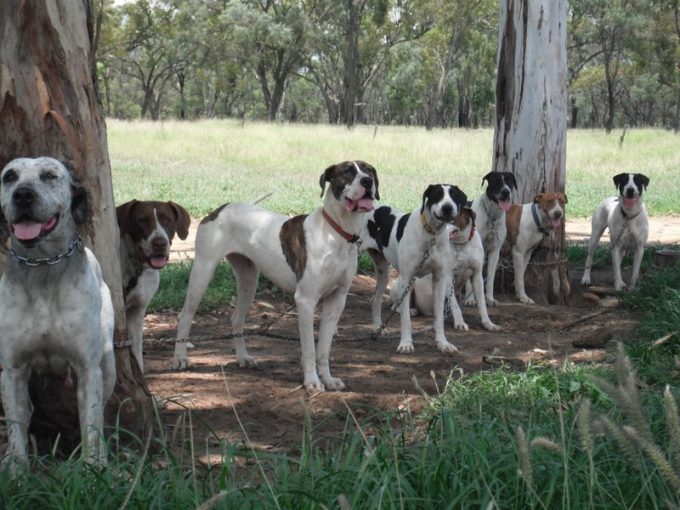If you are looking for a hunting dog that will become a valuable member of your family, consider the Bull Arab breed. It is one of the most popular dog breeds used for hunting pigs in Australia.
If the dog accompanies you on a hunt, you will never return home without a kill. But that’s not the only thing this dog has to offer.
The Bull Arab is a versatile breed. Good-natured and friendly especially toward children, the dog provides ample protection and companionship to any family, even those that don’t usually go hunting. If you do hunt, the dog will give you speed, agility, stamina, great scent-tracking, and athleticism.
In this article, we provide an in-depth look at the Bull Arab breed. We will cover its characteristics, breed history, physical traits, and many more.
This guide is the perfect package for you if you want to understand your Bull Arab better or if you are wondering whether this is the right dog breed for you or not.
Breed Characteristics

-
Adaptability: High; can adapt to a wide range of conditions.
-
Trainability: Below Average; needs to be trained from an early age by a firm and experienced trainer who will not be intimidated by the dog’s dominance.
-
Health and Grooming: Good; a low maintenance dog that does not have specific grooming instructions.
-
All Around Friendliness: Average; Bull Arabs tend to dominate other dogs and are aggressive towards strangers.
-
Exercise Needs: High Maintenance; this dog is a hunter and thus requires a very active lifestylу.
Today, it is a popular hunting breed and also serves as a companion and a guard dog. A strong and agile dog, the Bull Arab is loyal and is good-natured around children and family members.
The Bull Arab breed owes its origins to Australia. Mike Hodgens was the first one to breed the dog in 1972. Hodgens was looking for a dog that was perfect for hunting wild pigs.
The characteristics he was looking for were athleticism, strength, agility, and good tracking ability. The resultant was the Bull Arab breed.
For instance, your dog might have predominantly inherited the speed and sight of a Greyhound while another might have the power of the Bull Terrier.
The use of multiple dog breeds ensures that the Bull Arab has a vast gene pool, and thus, the dog has very few genetic problems. The Bull Arab dog is considered to be a healthy breed, and as the owner, you only need to take your dog for routine vaccinations and checkups to maintain optimum health.
The dog has a soft and short coat that needs little maintenance. Brushing the coat once per week will be enough to keep it well-groomed.
The Bull Arab dog is a very active dog. Since the Bull Arab is a hunter, the dog requires an open space so that he/she can exercise all they want and grow well. If you will be raising your Bull Arab in urban areas, ensure you exercise your dog daily.
When around other animals, a Bull Arab should always be supervised as he/she can get aggressive. Due to their hunting instinct and a strong sense of smell, Bull Arabs may chase other animals around.
The dog can also be aggressive around strangers. Obedience training and socialization from an early age are necessary to keep this dog in check.
Main Highlights

-
This is a dog that was bred to assist hunters. The breed was developed to hunt wild pigs and other animals.
-
Additionally, this is a great guard dog breed and has been used as police dogs and for search and rescue missions in Victoria.
-
The breed is a combination of the English Bull Terrier, the Greyhound, and the German Shorthaired Pointer. Some breeders argue that instead of a German Short Pointer, an English Pointer was used during the breeding.
-
The breed is also known as Australian Pig dog or Aussie Pig dog.
-
The breed is known for its stamina, strength, and superior tracking ability.
-
Most global dog associations have yet to recognize the breed officially, but the dog is still widely considered as one of the best hunting breeds in Australia.
-
The females can birth around seven to nine puppies at a time.
-
The dog does not thrive well in enclosed areas such as an apartment. They are best suited to an environment that keeps them busy with work as lack of physical activities might encourage destructive tendencies.
-
The dog’s diet should be made of meat, eggs, and dry kibble. The diet should also have the right amount of calcium for a growing dog.
-
The dog is extremely loyal to his/her owner and family. They can be quite playful. The dog is not aggressive to their owner or familiar faces. They are also very friendly to children.
-
However, due to their high prey drive, these dogs can be aggressive to pets and strangers. They should be taught socialization skills and trained at an early age to keep their aggression and prey drive in check.
Breed History

The Bull Arab was developed in the 1970s, with the credits given to Mike Hodgens. The dog is a crossbreed made up of ½ English Bull Terrier, ¼ Greyhound, and ¼ German Shorthair Pointer.
Hodgens was looking for a large dog that had speed, good tracking skills, and could be relied upon during hunts. The German Shorthair Pointer was chosen as the third option in the crossbreeding as opposed to the English Pointer as the former was less timid and has been used to track big game.
Since then, the breed has been developed further by other breeders with some, such as Peter Paulsen, introducing a 1/8 Bloodhound to increase the dog’s tracking ability, to toughen up the feed pads, and to increase the dog’s stamina. This variation is named the Peter Paulsen Bull Arabs.
The Bull Arab dog is mainly found in Australia and used to hunt pigs there. This dog is also a great addition to families as they can become great guard dogs and companions.
Although it is well known in Australia and has earned a reputation for itself as one of the best breeds for hunting, it is yet to be recognized as a pure breed by any dog association other than the Dog Registry of America (DRA).
Size
The height of your male Bull Arab will range from 63 to 69 cm or 25 to 27 inches while a female Bull Arab can reach a height between 60 to 66 cm or 24 to 26 inches.
The weight of the male will range between 32 and 42 kilos or 70 and 93 pounds while the female will weigh between 28 and 41 kilos or 65 and 90 pounds. These are the ideal heights and weights, but heavier and taller dogs do exist.
The Bull Arab is a strong and agile dog. It has muscular hindquarters and feet, and its toes are arched—meaning the dog can be very quick off the mark and can easily change directions when chasing prey.
The dog’s body structure is well-balanced with a head that is medium-sized. The dogs tend to have shining eyes that match the coat color.
The dogs have large to medium builds with medium-length ears. The head and the muzzle are powerful and moderately-sized. The dog’s teeth meet in a level bite, and the back is proportional to the dog’s height.
The tail and the legs have no feathering, and there is no double coat. The soft coat of the dog comes in different colors, including white, silver, black, tan, and brindle among others. Some have light or white spots and patches on their coats.
Also check How to Measure Your Dog
Personality and Character

This dog likes to perform tasks independently. These dogs have a busy character and can be bad-tempered. Additionally, they can be dominant, stubborn, and overly confident.
Their high prey drive can lead to an attack on livestock and pets. However, you’ll be hard-pressed to find a dog more loyal and reliable than this one.
Furthermore, Bull Arabs are friendly with all family members and very good with children.
They can be aggressive to strangers, but it’s just their protective instinct acting up. It can be trained out of them. This dog needs to learn socialization and training early to keep his/her prey drive in check.
Owners or trainers should also not allow the dog to dominate them, as the dog requires a firm hand to control.
However, if the dog is well-trained, he/she will always be obedient and listen to their owner’s command as this is a very loyal breed.
Due to their headstrong and active nature, these dogs may not be a suitable choice for first-time dog owners or owners that live in an apartment.
Health and Potential Problems

Due to the multiple dog breeds used to breed the Bull Arab, this dog is a healthy breed as the wide gene pool ensures they have few genetic problems. However, they do suffer from a few health problems, such as:
#1: Epilepsy
A neurological disorder that will cause your dog to have sudden and uncontrollable seizures. Most seizures will occur at night or early morning when the dog is resting. The recurring attacks can come with or without loss of consciousness.
The cause for this can be genetic, exposure to toxins, trauma, and other times due to unknown reasons. Younger dogs usually have more severe cases of epilepsy than older ones.
#2: Primary Lens Luxation (Pll)
This is a disorder that is characterized by weakened zonular fibers that lead to a luxation of the eye lenses. This disorder is very painful for the dog and, depending on the movement of the lens, it can cause blindness to your dog.
This disorder is often seen in dogs 3 to 6 years old. If your dog is genetically affected by PLL, take him or her to the vet every 6 months to evaluate and monitor their eye condition.
#3: Cataracts
This is cloudiness in the crystalline lenses of your dog’s eyes. Cataracts can be complete or partial. Dogs with less than 30 percent lens opacity show little or no symptoms while those with more than 60 percent opacity in their lens can have partial blindness or complete loss of vision.
Cataracts is a progressive disease and if not treated on time can cause blindness. The most suitable mode of treatment is early surgery.
#4: Cryptorchidism
Also referred to as undescended or retained testicles, this disorder occurs when both or one of your dog’s testicles do not descend to the scrotum and end up in the belly or the inguinal region.
The descending of the dog’s testicles to the scrotum occurs within two months of your puppy’s life and should be confirmed by your vet during the first puppy examination.
If left untreated, the disorder can cause testicular torsion that is a painful and complex condition. This disorder can also lead to testicular cancer. The most recommended solution for the problem is to have your dog neutered where both testicles are removed.
#5: Bloat
Bloat is often noted by an enlarged stomach, drooling, walking around, panting, and pained sounds. Excessive drinking, overeating, or exercising your dog immediately after a meal can make the problem worse.
The disorder happens when the dog’s stomach twists and becomes filled with gas that results in pressure to the diaphragm. This can cause breathing challenges and cuts the blood flow to the heart. Additionally, the pressure can lead to a rupture.
Treatments for bloat in dogs should be applied immediately as the disorder can be deadly to dogs. Surgery is the only way to untwist the twisted stomach.
Care Features

Bull Arabs are active dogs and need daily exercise. They also need room to play and run. If your dog does not get the much-needed exercise, he or she can show destructive tendencies such as chewing, whining, barking, and even property destruction.
The dog needs to learn critical behaviors such as socialization from his/her siblings and the mother for the first eight weeks after birth. Bull Arabs have a strong instinct to hunt and should be trained early enough as they may pose a danger to other animals including neighborhood pets and strangers.
Further, they need an experienced handler, as they can be stubborn and bored with repetitive exercises. If you are not an experienced handler, you need to train them in a confident and patient manner. It is best to establish respect, trust, and your dominance from a young age.
The trainer needs to be firm and serious with them to gain respect and obedience from the dogs.
Feeding Schedule
You can wean your puppy at eight weeks. Follow the breeder’s advice or food pack instructions on the quantity of feed.
If your dog does not eat the meal you put in the bowl for him in five minutes, take it back and do not replace it. Wait until the next mealtime and feed the dog as though he did not miss the last meal.
Lack of appetite may be a sign that your dog is unwell. Additionally, keep an eye on your dog’s weight to ensure he/she is not overweight. Do not forget to give them plenty of water.
Coat, Color, and Grooming

Most Bull Arabs are white with patches of black, buckskin, and brindle among other colors. They also have ticking on the white patches. It is also not uncommon to find Bull Arabs that are black, red, blue, silver, liver, or tan in color.
These dogs shed averagely and require minimal grooming skills since their hairs are short. Use a firm-bristled brush to comb the coat once per week and bathe your Bull Arab only when necessary.
As an occasional shedder, the fine and short undercoat of the dog ensures the dog’s comfort even during the shedding season. With their short coat, they thrive well in hot and humid locations. In cases of extreme cold, the dog should be kept warm.
Children and Other Pets Compatibility
This dog is good with children and has a gentle and sweet approach towards them. This is a loyal dog that will keep the family safe.
These dogs are normally good with other dogs although they have a tendency to dominate. The dog has a high prey drive and may chase other pets and livestock around. They can be aggressive to strangers and should always be safely secured when outdoors.
It is important to train and socialize these dogs from an early age, so they listen to you when you tell them not to chase after someone.
Wrap Up

The Bull Arab is a loyal dog with a great temperament. It is said to be the perfect breed for hunting wild pigs and other animals. With good stamina, amazing tracking ability, and the right speed, this dog has the perfect skills of a hunter.
Although they can get aggressive with strangers and other pets, these dogs can make great family pets if trained early and properly.
The perfect watchdogs, they are loyal to the family. Additionally, they have been used as police and rescue dogs.
What do you like about the Bull Arab breed? Would you keep one? If you already have one in your home, will you share your experiences with us? Let us know your opinion in the comment section below!
Sadly, if you live in apartments, this may not be a suitable dog breed for you as the Bull Arab needs space to exercise. You may want to check out our article on Best Dogs for Apartments instead.




